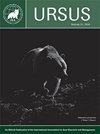印度中央邦Bandhavgarh老虎保护区树懒熊饮食的季节性变化
IF 0.6
4区 生物学
Q4 ZOOLOGY
引用次数: 9
摘要
摘要/ Abstract摘要:研究了2017年和2018年印度中央邦Bandhavgarh老虎保护区以人类为主导的缓冲区中树懒熊(Melursus ursinus)食物习性的季节变化。我们分析了夏季的109张树懒熊粪便和冬季的103张树懒熊粪便,以表征食物习惯的季节性变化。我们使用相对重要性指数(IRI)来确定每个食品项目的重要性。冬小麦果实IRI得分在夏季最高,白蚁果实IRI得分在冬季最高。树懒熊的食性有明显的季节差异(χ2 = 143.3, 10 df, P < 0.01)。昆虫(白蚁和蚂蚁)是树懒熊最重要的食物来源,在夏季和冬季分别贡献了估计膳食能量含量(EDEC)的41%和95%。我们发现,树懒熊在夏季主要以6种植物的果实为食,其中包括入侵杂草Lantana camara的果实。金合欢果(决明子)和胭脂树(胭脂树)的消耗比例低于可利用率,而天牛果的消耗比例与可利用率成正比。树懒熊没有吃过任何大型脊椎动物。食物项稳定曲线显示,夏季需要70份,冬季需要80份,才能充分描述树懒熊的饮食。树懒熊和其他野生动物对L. camara的食用在种子传播和这种入侵杂草的传播方面具有很强的管理意义。本文章由计算机程序翻译,如有差异,请以英文原文为准。
Seasonal variation in the diet of sloth bears in Bandhavgarh Tiger Reserve, Madhya Pradesh, India
Abstract: We studied seasonal variation in food habits of sloth bears (Melursus ursinus) in the human-dominated buffer zone of the Bandhavgarh Tiger Reserve, Madhya Pradesh, India, during 2017 and 2018. We analyzed 109 sloth bear scats from summer and 103 from winter to characterize the seasonal variation in food habits. We used the Index of Relative Importance (IRI) to determine the importance of each food item. Tendu (Diospyros melanoxylon) fruits had the highest IRI score in summer and termites had the highest IRI score in winter. There was a distinct seasonal variation in the food habits of the sloth bears (χ2 = 143.3, 10 df, P < 0.01). Insects (termites and ants) were the most important food source for sloth bears, contributing 41% and 95% of the Estimated Dietary Energy Content (EDEC) during summer and winter, respectively. We found that sloth bears fed primarily on the fruits of 6 plant species in summer, including the fruits of the invasive weed, Lantana camara. Fruits of amaltas (Cassia fistula) and char (Buchanania cochinchinensis) were consumed in a lower proportion than available, whereas the fruits of tendu were consumed in proportion to availability. Sloth bears had not consumed any large vertebrate species. The food items stabilization curve showed that 70 scats in summer, and 80 scats in winter, were required to depict the diet of sloth bear adequately. Consumption of L. camara by sloth bears, as well as other wildlife species, has strong management implications in terms of seed dispersal and the spreading of this invasive weed.
求助全文
通过发布文献求助,成功后即可免费获取论文全文。
去求助
来源期刊

Ursus
生物-动物学
CiteScore
2.00
自引率
15.40%
发文量
12
审稿时长
>12 weeks
期刊介绍:
Ursus includes a variety of articles on all aspects of bear management and research worldwide. Original manuscripts are welcome. In addition to manuscripts reporting original research, submissions may be based on thoughtful review and synthesis of previously-reported information, innovative philosophies and opinions, and public policy or legal aspects of wildlife conservation. Notes of general interest are also welcome. Invited manuscripts will be clearly identified, but will still be subject to peer review. All manuscripts must be in English. All manuscripts are peer-reviewed, and subject to rigorous editorial standards.
 求助内容:
求助内容: 应助结果提醒方式:
应助结果提醒方式:


